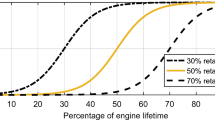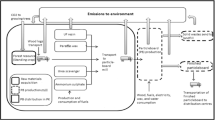Abstract
With the acceleration of globalization, trade between countries has become more and more frequent; as a kind of commonly used heavy lifting equipment, the influence of the quayside crane on environment during the production stage has attracted wide attention. In this paper, the world’s largest quayside crane manufacturer was selected as the study object. The environmental load of five workshops (NC pre-treatment workshop, assembling workshop, sand milling workshop, painting workshop and steel structure workshop) involved in the quayside crane (QC) production stage was studied by using the ReCiPe model; the normalized values of the 14 overall pollutants in each workshop were 1248.64, 576.75, 214.27, 85.26 and 76.69, respectively. The results showed that the sand milling workshop was the biggest electricity consumer of all processes. The sensitivity analysis revealed that the environmental pollution load was the most sensitive to the electricity consumption; the scenario analysis indicated that with the proportion of China’s renewable resources in the process of electricity generation becoming larger and larger, in comparison with that of in 2015, up to 2050, the quantity of PM 2.5 generated during the production process of QC will drop from 832 to 408 kg (high-speed development)/342 kg (low-speed development), and it is expected that the China’s haze problem could be effectively curbed in the future. Finally, the research results of this article also pointed out the direction for the future technical innovation of the QC industry.
Graphical abstract






Similar content being viewed by others
References
Cederberg, C. (1998). Life cycle assessment of milk production: A comparison of conventional and organic farming. Göteborg, Sverige: SIK Institutet för livsmedel och bioteknik.
Chen, C., & Lam, J. S. L. (2018). Sustainability and interactivity between cities and ports: A two-stage data envelopment analysis (DEA) approach. Maritime Policy & Management,45, 1–18.
Cheon, S., Maltz, A., & Dooley, K. (2017). The link between economic and environmental performance of the top 10 US ports. Maritime Policy & Management,44(2), 227–247.
Cui, Q. (2017). Environmental efficiency measures for ports: An application of RAM-Tobit-RAM with undesirable outputs. Maritime Policy & Management,44(5), 551–564.
Cui, X., Hong, J., & Gao, M. (2012). Environmental impact assessment of three coal-based electricity generation scenarios in China. Energy,45, 952–959.
Dong, Y. H., & Ng, S. T. (2014). Comparing the midpoint and endpoint approaches based on ReCiPe—A study of commercial buildings in Hong Kong. The International Journal of Life Cycle Assessment,19, 1409–1423.
Editorial Committee of China Power Yearbook. (2015). China electric power yearbook 2014. Beijing: China Electrical Power Press.
Fransoo, J. C., & Lee, C.-Y. (2013). The critical role of ocean container transport in global supply chain performance. Production and Operations Management,22, 253–268.
Gharehgozli, A. H., Roy, D., & de Koster, R. (2016). Sea container terminals: New technologies and OR models. MEL,18, 103–140.
Goh, M., & Ling, C. (2003). Logistics development in China. International Journal of Physical Distribution & Logistics Management,33, 886–917.
https://thinkstep.com/sustainability-data/lci-data/global-industrial-process.
ISO, I. (2006). 14040: Environmental management–life cycle assessment–principles and framework. London: British Standards Institution.
Lardon, L., Helias, A., Sialve, B., Steyer, J.-P., & Bernard, O. (2009). Life-cycle assessment of biodiesel production from microalgae. Washington, DC: ACS Publications.
Li, M., & Zhang, L. (2014). Haze in China: Current and future challenges. Environmental Pollution,189, 85–86.
Rebitzer, G., Ekvall, T., Frischknecht, R., Hunkeler, D., Norris, G., Rydberg, T., et al. (2004). Life cycle assessment: Part 1—Framework, goal and scope definition, inventory analysis, and applications. Environment International,30, 701–720.
Ripa, M., Fiorentino, G., Giani, H., Clausen, A., & Ulgiati, S. (2017). Refuse recovered biomass fuel from municipal solid waste. A life cycle assessment. Applied Energy,186, 211–225.
Roy, P., Nei, D., Orikasa, T., Xu, Q., Okadome, H., Nakamura, N., et al. (2009). A review of life cycle assessment (LCA) on some food products. Journal of Food Engineering,90, 1–10.
Schroeder, M. (2009). Utilizing the clean development mechanism for the deployment of renewable energies in China. Applied Energy,86, 237–242.
Sharma, A., Saxena, A., Sethi, M., & Shree, V. (2011). Life cycle assessment of buildings: A review. Renewable and Sustainable Energy Reviews,15, 871–875.
State-Owned Assets Supervision and Administration Commission of the State Council. (2016). The global share of ZPMC of China Communications Group is up to a record again. http://www.sasac.gov.cn//n2588025/n2588124/c3827304/content.html. Accessed 19 Aug 2016.
Su, S., Zhao, J., & Jianxin, H. (2015). Greenhouse gas emissions from power sector in China from 1990 to 2050. Advances in Climate Change Research,11, 353–362.
Wang, L., Notteboom, T., Lau, Y.-Y., & Ng, A. (2017). Functional differentiation and sustainability: A new stage of development in the Chinese container port system. Sustainability-Basel,9, 328.
Wen, B., Jin, Q., Huang, H., Tandon, P., & Zhu, Y. (2017). Life cycle assessment of Quayside crane: A case study in China. Journal of Cleaner Production,148, 1–11.
ZPMC brief introduction. http://cn.zpmc.com/invite.php.
ZPMC. (2019). http://cn.zpmc.com/pro/list.aspx?id=3. Accessed 11 Jan 2019.
Acknowledgements
This study was supported by National Natural Science Foundation of China (21476139). We would also like to acknowledge all of the enterprise and experts for their assistance in interviews and data collection. We also appreciate the anonymous reviewers for their valuable comments.
Author information
Authors and Affiliations
Corresponding authors
Additional information
Publisher's Note
Springer Nature remains neutral with regard to jurisdictional claims in published maps and institutional affiliations.
Rights and permissions
About this article
Cite this article
Liu, Y., Jin, Q., Wen, B. et al. The economic and environmental assessment on production stage of quayside crane. Environ Dev Sustain 22, 2759–2778 (2020). https://doi.org/10.1007/s10668-019-00316-5
Received:
Accepted:
Published:
Issue Date:
DOI: https://doi.org/10.1007/s10668-019-00316-5




